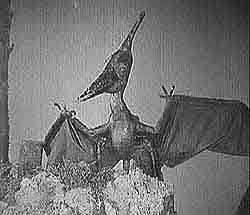 The silent film version of The Lost World (1925) is even today a powerful adaptation of Sir Arthur Conan Doyle's influential 1912 classic tale of an isolated South American plateau whereon dwell prehistoric man & dinosaurs. The version I most recently watched was 90 minutes long, with over twenty minutes of additional footage rediscovered in Europe in the early '90s. The silent film version of The Lost World (1925) is even today a powerful adaptation of Sir Arthur Conan Doyle's influential 1912 classic tale of an isolated South American plateau whereon dwell prehistoric man & dinosaurs. The version I most recently watched was 90 minutes long, with over twenty minutes of additional footage rediscovered in Europe in the early '90s.
Wallace Beery stars as Professor Challenger. Bull Montana plays the ape-man wonderfully well, in a stunning make-up design not one-tenth as hoky as those ape suits that would dominate the next fifty years' worth of ape movies.
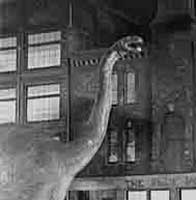 The special effects are by Willis O'Brien who also brought King Kong to life. It may be a tad difficult to keep from grinning at the stop motion dinosaurs nowadays, but there is distinct charm to this animation, & they must've been truly terrifying in 1925. The special effects are by Willis O'Brien who also brought King Kong to life. It may be a tad difficult to keep from grinning at the stop motion dinosaurs nowadays, but there is distinct charm to this animation, & they must've been truly terrifying in 1925.
Professor Challenger brings a brontosaurus back to London for the climactic scenes of people fleeing through the streets to escape the destruction. This vision of a dinosaur rampage is as full-bodied as any that have since followed this exact formula.
The faults of the film include the inclusion of a presumedly African servant named Sambo who is a white guy in black face (Jules Cowles); & plot-wise, when our explorers reach the high plateau, they don't stay long, & all they see on their brief stay is a lot of dinosaurs killing each other. They'd be extinct in a couple weeks if they really got in fights-to-the-death once every minute & a half.
Even at that, the film requires fewer forgivenesses of age than one might've expected especially of an FX driven story of this vintage.
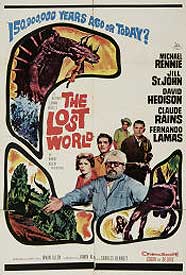 The silent film version of The Lost World was an international success & plans arose almost immediately to refilm it as a talkie. But those plans fell apart & it was quite some while before Irwin Allen's The Lost World (1960) gave voice to Challenger & roars to dinos. The silent film version of The Lost World was an international success & plans arose almost immediately to refilm it as a talkie. But those plans fell apart & it was quite some while before Irwin Allen's The Lost World (1960) gave voice to Challenger & roars to dinos.
It's an amusing film though many people laugh at the regular lizards dressed up with prosthetics to pose as dinosaurs. Stop motion animation had advanced considerably but was time consuming thus expensive, & Irwin Allen liked to go affordable routes.
The wacky thing is Willis O'Brien is the one who got the project off the ground intending to do a film that would probably remain forever after the definitive Lost World. Willis was paid & given credit as , but he was denied the privilege of actually providing the FX. It was one of the heartbreaks of his life & to this day there has never really been a version of Lost World to do justice to Sir Arthur Conan Doyle's original novel.
But even with modern lizards posing as dinos, an iguana with a horn glued on is frankly more interesting than the modern CGI versions, & in another fifty years Allen's tricked out lizards will be as amusing as ever, whereas the Jurassic Park cycle will be only cartoon animation.
It's a fun B movie no matter how cornpone. There are lots of incidents in the Amazonian high plateau, & a sterling cast headed up by Claude Rains as Challenger, Michael Rennie as Roxton, Fernando Lamas & Jay Novello as the bad guys, & Jill St. Johns as romantic interest.
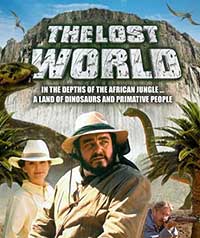 The Lost World (1992) & its immediate sequel Return to the Lost World (1993) are Canadian productions directed by Timothy Bond. John Rhys-Davies plays Professor Challenger with stentorial conviction & David Warner is Summerlee. In the first film Challenger's expedition finds an isolated plateau, this time in the Belgian Congo, with dinosaurs, & primitive humans whom Challenger assists. The Lost World (1992) & its immediate sequel Return to the Lost World (1993) are Canadian productions directed by Timothy Bond. John Rhys-Davies plays Professor Challenger with stentorial conviction & David Warner is Summerlee. In the first film Challenger's expedition finds an isolated plateau, this time in the Belgian Congo, with dinosaurs, & primitive humans whom Challenger assists.
In the sequel set two years later (in 1914) white guys kill dinosaurs & make life miserable for the tribe. Challenger joins with the aborigines of Lost World to stop western exploitation.
The dinosaur FX are few & mediocre & a great example of how fast "state of the art" CGI animation looks creeky, as opposed to older stop moton animation that looks forever either as artistic or inartistic as the day it was done. Still, the key cast's hutzpah carries it all along quite thrillingly.
Both films were shot simultaneously in Zimbabwe -- an interesting change of venue since Doyle set the tale in South America, not in Zimbabwe which is more identified with H. Rider Haggard's lost race tales.
copyright © by Paghat the Ratgirl
|
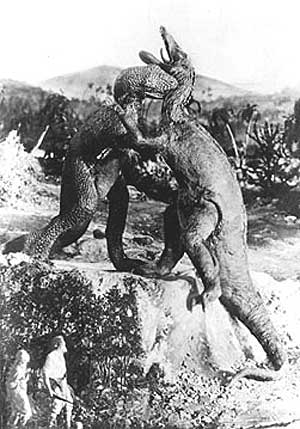

 The special effects are by Willis O'Brien who also brought King Kong to life. It may be a tad difficult to keep from grinning at the stop motion dinosaurs nowadays, but there is distinct charm to this animation, & they must've been truly terrifying in 1925.
The special effects are by Willis O'Brien who also brought King Kong to life. It may be a tad difficult to keep from grinning at the stop motion dinosaurs nowadays, but there is distinct charm to this animation, & they must've been truly terrifying in 1925.
